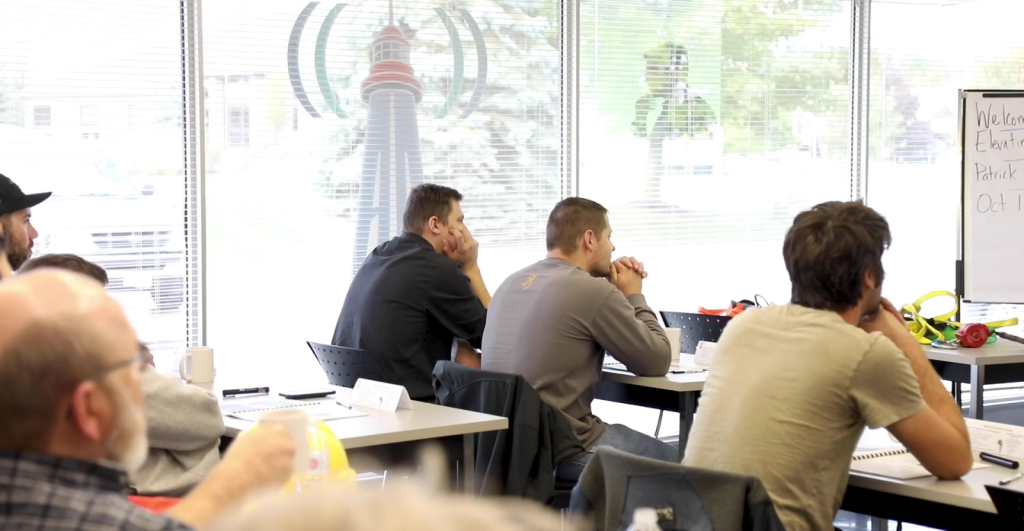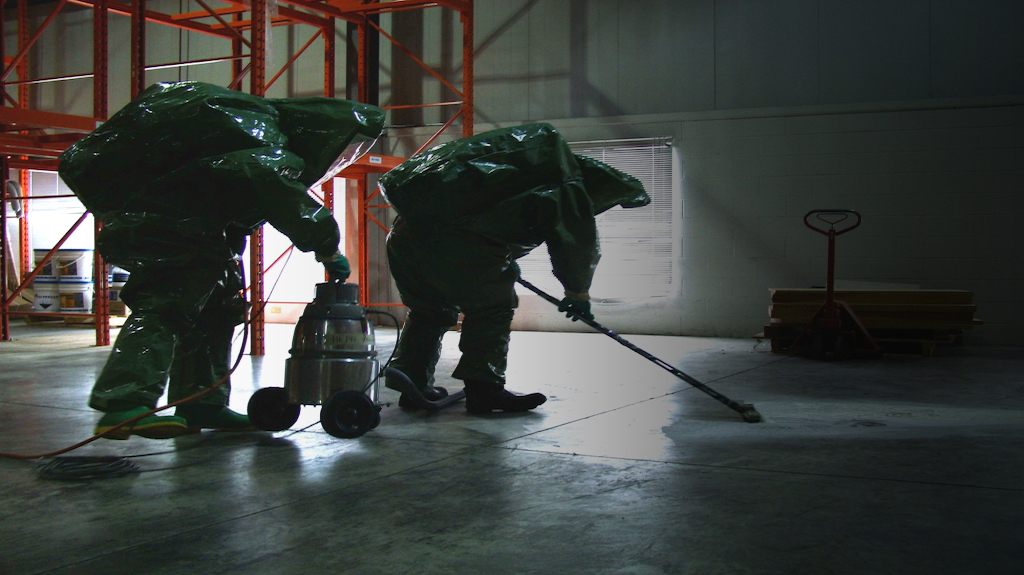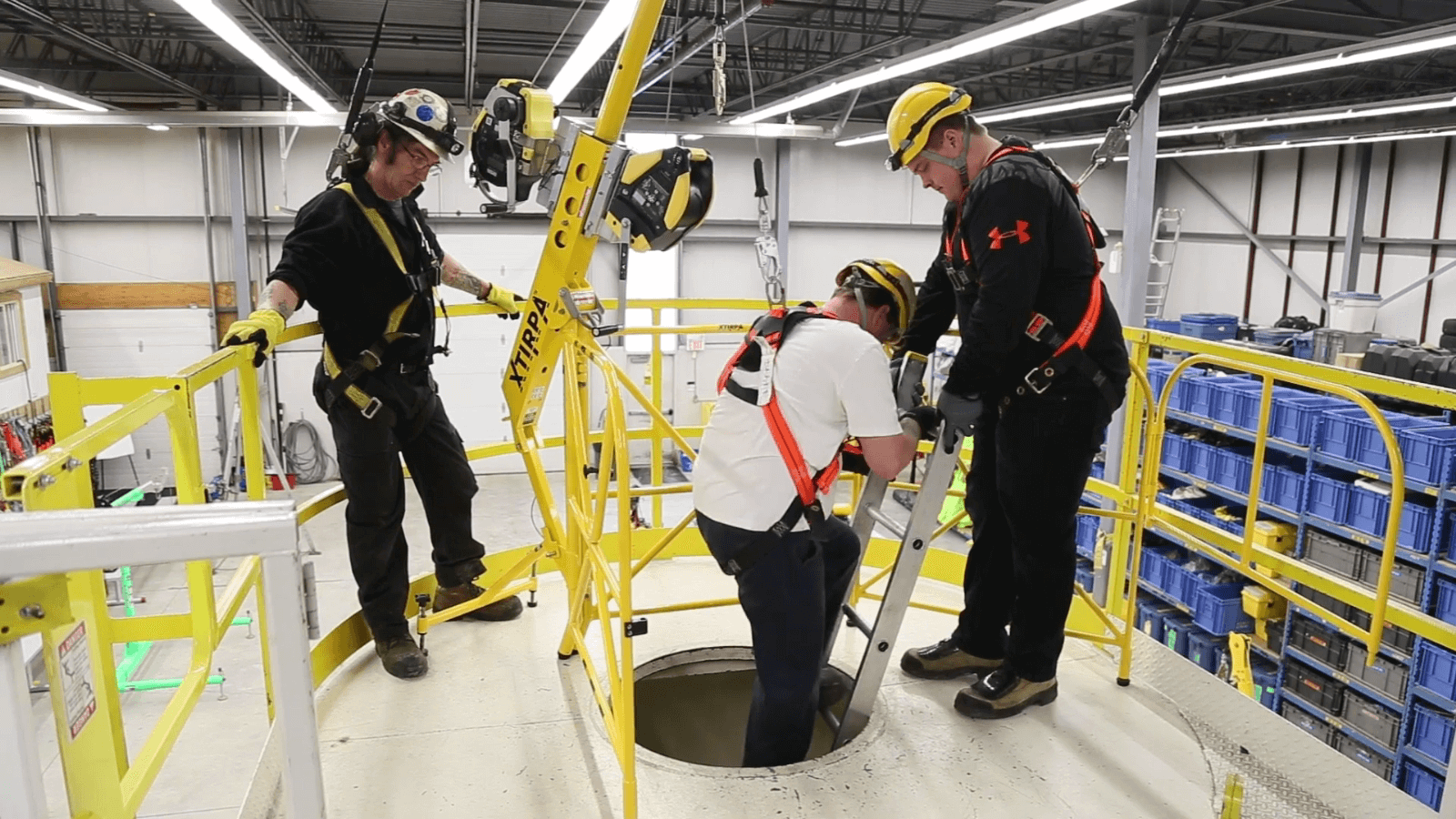Here are 12 great safety presentation ideas you can use in your workplace. Click on each idea to learn more.
- Preventing slips, trips, and falls
- Responding to hazardous spills
- Working on an elevated work platform
- Prevent workplace violence and harassment
- Ergonomics in the warehouse
- Ergonomics in the office
- Personal Protective Equipment 101
- Stress in the workplace
- Fire prevention and safety
- Working safely in confined spaces
You can trust ACUTE for the best safety training possible. ACUTE’s experienced team members have been serving safety professionals for over 20 years. For professional health and safety training, contact ACUTE.
Key Takeaways
- This ACUTE blog post presents 12 practical safety presentation ideas to help improve workplace safety, covering common hazards like slips, trips and falls; hazardous spill response; elevated platform use; workplace violence and harassment; ergonomics; PPE basics; stress management; fire prevention; and confined space safety.
- Each topic includes real-world advice on preventative measures, proper procedures, and engineering or administrative controls.
- The post emphasizes relevant safety practices like non-slip flooring, fall protection, PPE use, and timely training—to reduce risks and protect employees.
- With almost 30 years of experience in safety training, ACUTE offers these ideas as ready-to-use tools alongside its expert services.

Here are some helpful safety presentation ideas for your workplace
12 Safety Presentation Ideas
1. Preventing slips, trips, and falls
The primary cause of most slips, trips and falls in the workplace are caused by things that stick up a half-inch off the floor such as:
- Curled-up carpets
- Cords
- Tools
- Uneven flooring
- Floor mats
Here are some more safety presentation ideas:
Engineering Controls
- Non-slip flooring: Install slip-resistant flooring in areas where spills or wet conditions are common, such as kitchens, bathrooms, and production areas.
- Proper lighting: Ensure adequate lighting in all areas of the workplace to prevent tripping hazards.
- Clear pathways: Keep walkways and work areas free of clutter and obstructions to prevent tripping.
- Handrails and guardrails: Provide handrails on stairs and guardrails on elevated platforms to prevent falls.
Administrative Controls
- Regular inspections: Conduct regular inspections of the workplace to identify and address potential hazards.
- Training and education: Train employees on how to identify and avoid slip, trip, and fall hazards.
- Safety policies and procedures: Develop and implement clear safety policies and procedures to address slip, trip,and fall prevention.
- Incident reporting: Encourage employees to report any near-misses or accidents to help identify and address underlying causes.
Personal Protective Equipment (PPE)
- Appropriate footwear: Provide employees with appropriate footwear that has slip-resistant soles.
- Fall protection: Use fall protection equipment, such as harnesses and lifelines, when working at heights.
Additional Tips
- Clean up spills immediately: Address spills promptly to prevent slips.
- Mark wet areas: Use caution signs or cones to warn employees of wet or slippery areas.
- Use caution when carrying objects: Avoid carrying objects that obstruct your vision or make it difficult to maintain balance.
- Be aware of your surroundings: Pay attention to your surroundings and watch for potential hazards.
The majority of workplace accidents happen when you trip, slip, or fall. This common type of workplace accident can cause back injuries, strains, sprains, contusions, or fractures.
Here’s a helpful video that that you could include in your presentation.
By implementing these strategies, you can significantly reduce the risk of slips, trips, and falls in your workplace, creating a safer and more productive environment for your employees.
Learn how to prevent trips, slips, and falls
2. Responding to hazardous spills
During this safety presentation, you can cover such helpful topics as:
- How to respond safely to accidental spills, leaks, or releases of both hazardous and non-hazardous materials to the environment
- How you can help eliminate or minimize the adverse effects that could occur if a spill happens
You can download this FREE spill response plan template to help you prepare for your presentation.
Here are some tips:
Immediate Action:
- Isolate the area: Prevent further contamination by restricting access to the spill area.
- Evacuate if necessary: If the spill poses an immediate threat to health or safety, evacuate personnel from the area.
- Stop the leak: If possible, safely stop the source of the spill.
Personal Protective Equipment (PPE):
- Assess the hazard: Determine the type of chemical spilled and the appropriate PPE required.
- Wear appropriate gear: This may include gloves, goggles, respiratory protection, and protective clothing.
Spill Containment:
- Absorbent materials: Use appropriate absorbent materials, such as sand, clay, or specialized spill kits, to contain the spill.
- Dams or dikes: Create temporary barriers to prevent the spill from spreading.
Cleanup and Disposal:
- Follow guidelines: Adhere to specific guidelines for cleaning up and disposing of hazardous materials.
- Proper disposal: Dispose of contaminated materials according to local regulations.
Emergency Response:
- Contact authorities: If the spill is large or poses a significant threat, contact emergency services (e.g., fire department, hazardous materials team).
Post-Spill Procedures:
- Decontamination: Thoroughly decontaminate the affected area and equipment.
- Investigation: Conduct an investigation to determine the cause of the spill and implement corrective measures to prevent future incidents.
Remember: Always prioritize safety when responding to hazardous spills. If you are unsure about how to handle a specific spill, consult with a qualified professional or refer to relevant safety data sheets (SDS).

3. Working on an elevated work platform
If your workplace uses elevated work platforms, it’s important to make sure that your employees have the proper trainingabout how to use them safely and to ensure that the equipment itself is not defective.
Elevating work platforms such as scissor lifts and boom lifts can be a great solution to the challenges of working at heights, however, they need to be used properly. Doing a refresher course on the safe use of this type of equipment frequently is a good idea.
Safety presentation ideas include:
Safety Considerations:
When working on elevated work platforms (EWPs), such as scaffolding or aerial lifts, it’s crucial to prioritize safety to prevent accidents and injuries. Here are some essential guidelines:
- Inspection and Maintenance:
- Ensure that the EWP is inspected regularly and is in good working condition.
- Check for any damage, loose bolts, or worn components.
- Follow the manufacturer’s guidelines for maintenance and inspection.
- Proper Training:
- All workers who operate or work near EWPs should receive adequate training on their safe use.
- The training should cover operation procedures, safety features, and potential hazards.
- Fall Protection:
- Always use appropriate fall protection equipment, such as harnesses, lifelines, and safety lanyards.
- Ensure that the fall protection system is properly installed and inspected before use.
- Load Capacity:
- Never exceed the EWP’s rated load capacity.
- Avoid overloading the platform with tools, materials, or personnel.
- Weather Conditions:
- Do not operate EWPs in severe weather conditions, such as high winds, heavy rain, or lightning.
- Electrical Hazards:
- Be aware of electrical hazards and maintain a safe distance from power lines.
- Use insulated tools and equipment when working near electrical sources.
- Stability:
- Ensure that the EWP is placed on a stable surface and is properly leveled.
- Avoid working on uneven or sloping ground.
- Emergency Procedures:
- Develop and practice emergency procedures, such as evacuation plans and first aid.
By following these guidelines, you can significantly reduce the risk of accidents and injuries when working on elevated work platforms.

You need proper training when working on elevated work platforms
4. Preventing workplace violence and harassment
NO form of harassment should be accepted in your workplace. Unfortunately, workplace violence and harassment doeshappen, so it is one of the safety presentation ideas that needs to be addressed.
You should cover such important topics such as:
- Sexual harassment
- Bullying
- How to deal with harassment
- Legal concept of workplace harassment in Ontario
Some ideas to talk about in your safety presentation are:
Develop a Clear Policy
- Create a comprehensive policy: Clearly outline what constitutes workplace violence and harassment, including physical, verbal, psychological, and sexual harassment.
- Communicate the policy: Ensure that all employees are aware of the policy and understand its implications.
- Provide training: Conduct regular training sessions to educate employees about the policy and its consequences.
Foster a Respectful Workplace Culture
- Promote open communication: Encourage employees to speak up if they witness or experience harassment or violence.
- Respectful behaviour: Model respectful behaviour at all levels of the organization.
- Diversity and inclusion training: Promote diversity and inclusion to create a more welcoming and inclusive environment.
Implement Prevention Measures
- Workplace assessments: Conduct regular assessments to identify potential risk factors.
- Security measures: Implement security measures such as access controls, surveillance, and emergency response plans.
- Conflict resolution training: Provide training on conflict resolution and de-escalation techniques.
Investigate and Address Incidents
- Prompt investigation: Investigate all reports of harassment or violence promptly and thoroughly.
- Disciplinary action: Take appropriate disciplinary action against offenders.
- Support for victims: Provide support and resources for victims of harassment or violence.
Provide Employee Assistance Programs (EAPs)
- Confidentiality: Ensure that EAPs provide confidential counselling and support services.
- Accessibility: Make EAPs easily accessible to all employees.
By implementing these strategies, organizations can create a safer and more respectful workplace for all employees.
Remember: Prevention is key. By fostering a positive workplace culture and taking proactive measures, you can significantly reduce the risk of workplace violence and harassment.
The following video explains your rights in Ontario regarding workplace harassment.
Safety presentation ideas: include a talk on harassment
5. Ergonomics in the warehouse
When you think about ergonomics, office ergonomics usually comes to mind first. However there are many ergonomic issues that should also be addressed in other workplaces, like warehouses. Your topics could include:
- Proper lifting techniques
- Using equipment properly
- Proper seating positions in forklifts and other machinery
You can also discuss:
Manual Handling:
- Set reasonable weight limits for manual handling tasks.
- Mechanical aids: Use mechanical aids like forklifts or pallet jacks to reduce manual handling.
Workplace Layout:
- Efficient layout: Design the warehouse layout to minimize walking distances and reduce repetitive movements.
- Storage height: Ensure that items are stored at a comfortable height to avoid excessive reaching or bending.
- Adequate space: Provide sufficient space for employees to move around safely.
Equipment Design:
- Ergonomic tools: Use tools and equipment that are designed to reduce strain on the body.
- Adjustable workstations: Ensure that workstations can be adjusted to fit individual employees’ needs.
Rest Breaks:
- Regular breaks: Schedule regular breaks throughout the workday to allow employees to rest and recover.
- Microbreaks: Encourage employees to take short, frequent microbreaks to reduce fatigue.
By implementing ergonomic principles in your warehouse, you can create a safer and more productive work environment.
My company deals exclusively with Acute for our respirator fit test needs. Michelle from Acute is extremely easy and accommodating to work with and responds promptly to our inquiries. Everyone else there that our employees have worked with have been professional and meet our needs.
6. Ergonomics in the office
With so many people working jobs where they sit at a desk in front of a computer screen all day, learning about ergonomics in an office setting is an incredibly important safety presentation idea.
Some points to meantion are:
Desk and Chair Setup:
- Adjustable height: Ensure your desk and chair can be adjusted to a comfortable height, allowing your feet to rest flat on the floor and your elbows to be at a 90-degree angle.
- Lumbar support: Use a lumbar support cushion to maintain a natural curve in your lower back.
- Armrests: Adjust armrests to support your forearms when typing or using a mouse.
Computer Monitor:
- Proper distance: Position the monitor at a comfortable distance, typically about an arm’s length away.
- Eye level: Adjust the monitor height so that the top of the screen is at eye level.
- Reduce glare: Use an antiglare screen or adjust the monitor’s brightness to reduce glare.
Keyboard and Mouse:
- Neutral wrist position: Avoid bending your wrists excessively when typing or using a mouse.
- Wrist rests: Use wrist rests to support your wrists and prevent strain.
- Keyboard layout: Consider using an ergonomic keyboard with a split layout and a more natural wrist position.
Lighting:
- Natural light: Maximize natural light in your workspace.
- Task lighting: Use task lighting to illuminate your work area without creating glare.
- Avoid harsh lighting: Avoid harsh overhead lighting that can cause eye strain.
Breaks and Posture:
- Regular breaks: Take short breaks every 20-30 minutes to stretch and rest your eyes.
- Good posture: Maintain good posture throughout the day, sitting up straight with your shoulders relaxed.
Customized Workstations:
- Individual needs: If you have specific ergonomic needs, consult with a healthcare professional or an ergonomics specialist to customize your workstation.
By implementing ergonomic principles in your office, you can create a healthier and more productive work environment.
This video below can help you prepare for this topic.
Here are some great tips to prevent eye strain
7. Personal Protective Equipment 101
One of the best safety presentation ideas is to go over the various items that you workers use for their personal protection to make sure that they are wearing or using the equipment that they need to and to make sure that it fits them properly.
If your workers need to wear a respirator for their job, then it is a good idea to get quantitative fit testing done to ensure a proper and safe fit.
Types of PPE to discuss are:
- Head Protection: Helmets, hard hats, and bump caps are used to protect the head from falling objects, impact injuries, and electrical hazards.
- Eye and Face Protection: Safety glasses, goggles, face shields, and respirators protect the eyes and face from flying particles, chemicals, and harmful fumes.
- Hearing Protection: Earplugs and earmuffs are used to protect the ears from excessive noise exposure.
- Respiratory Protection: Respirators are used to protect the respiratory system from inhaling harmful airborne contaminants.
- Hand Protection: Gloves are used to protect the hands from cuts, burns, chemicals, and biological hazards.
- Skin Protection: Protective clothing, such as coveralls, aprons, and sleeves, can be used to protect the skin from chemicals, biological hazards, and physical injuries.
- Foot Protection: Safety shoes or boots are used to protect the feet from falling objects, crushing hazards, and electrical hazards.
Factors to Consider When Choosing PPE:
- Nature of the Hazard: The type of PPE needed will depend on the specific hazard being faced.
- Fit and Comfort: PPE must fit properly and be comfortable to wear for extended periods.
- Durability: PPE should be durable and able to withstand the rigors of the workplace.
- Maintenance: PPE should be regularly inspected, cleaned, and maintained according to manufacturer’s instructions.
By understanding the different types of PPE and following proper safety procedures, employers can create a safer and healthier workplace for their employees.

8. Stress in the workplace
Workplace stress, depression, anxiety, and other mental health issues make up a large proportion of workplace health issues.
You could address some of the main contributing factors to workplace stress including:
Common Mental Health Issues in the Workplace
- Stress: High workloads, tight deadlines, and difficult colleagues can contribute to stress.
- Anxiety: Worry, fear, and excessive nervousness can affect job performance and relationships.
- Depression: Symptoms like sadness, hopelessness, and loss of interest can significantly impact work productivity.
- Burnout: Chronic stress and exhaustion can lead to burnout, characterized by emotional exhaustion, cynicism, and reduced performance.
The Impact of Mental Health on the Workplace
- Reduced productivity: Mental health issues can decrease employee productivity and efficiency.
- Increased absenteeism: Employees struggling with mental health may be more likely to take time off work.
- Decreased job satisfaction: Mental health problems can lead to lower job satisfaction and morale.
- Negative workplace culture: A toxic work environment can exacerbate mental health issues.
Promoting Mental Health in the Workplace
- Create a supportive culture: Foster a culture of open communication, empathy, and respect.
- Offer mental health resources: Provide access to mental health professionals, employee assistance programs (EAPs), and other support services.
- Encourage work-life balance: Promote healthy work-life balance through flexible work arrangements and stress management techniques.
- Address stigma: Challenge stigma surrounding mental health and encourage employees to seek help.
- Provide training: Educate employees about mental health awareness and how to support colleagues.
By prioritizing mental health in the workplace, organizations can create a healthier, more productive, and more supportive environment for their employees.

Address mental health issues in your safety presentations
9. Fire prevention and safety
Talking about fire safety another great safety prevention idea. Many deaths and injuries caused by fire or explosions in the workplace can be prevented by implementing emergency action plans, fire prevention plans, and practising fire protection procedures.
Your talk could include instructions about:
Fire Safety Plan
- Fire hazard identification: Conduct regular inspections to identify potential fire hazards, such as combustible materials, electrical hazards, and blocked exits.
- Evacuation procedures: Develop clear evacuation procedures and ensure that all employees are familiar with them.
- Emergency exits: Ensure that all emergency exits are clearly marked, accessible, and unobstructed.
- Fire extinguishers: Provide appropriate fire extinguishers in strategic locations throughout the workplace.
- Fire alarms: Install and regularly test smoke detectors and fire alarms.
- Employee training: Conduct regular fire drills and safety training for all employees.
Common Fire Hazards in the Workplace:
- Electrical equipment: Overloaded circuits, faulty wiring, and damaged equipment can be significant fire hazards.
- Combustible materials: Clutter, improperly stored flammable materials, and wastebaskets can fuel fires.
- Cooking areas: Unattended cooking, grease buildup, and improper storage of cooking materials can pose fire risks.
- Smoking areas: Improperly discarded cigarettes and smoking materials can cause fires.
Preventing Fires:
- Regular inspections: Conduct regular inspections to identify and address potential fire hazards.
- Maintenance: Ensure that electrical equipment is properly maintained and inspected regularly.
- Proper storage: Store flammable materials in designated areas and follow safety guidelines.
- Smoking policies: Implement clear smoking policies and provide designated smoking areas.
- Employee education: Educate employees about fire safety and the proper use of fire extinguishers.
Here’s a great video that can help you prepare for your talk.
Safety presentation ideas: Address fire prevention and safety
10. How to work safely in confined spaces
Confined spaces are high risk work areas that can kill both workers and rescuers. Very specific rules need to be followed by workers who work in and around these spaces.
Confined space entry training is another course that should be taught by professionals. This type of training will help you recognize confined space entry risks and how to establish measured and corresponding controls. You will also become familiar with, inspect and use Confined Space Entry (CSE) access equipment and air quality instrumentation.
A confined space rescue program teaches you how to safely perform a rescue from a confined space.
You can bring up:
Common Hazards in Confined Spaces:
- Oxygen deficiency: Lack of oxygen can lead to suffocation.
- Toxic gases: Hazardous gases can accumulate in confined spaces.
- Entrapment: Workers can become trapped due to equipment failure or other reasons.
- Electrical hazards: Electrical equipment can pose a risk in confined spaces.
Safety Precautions for Working in Confined Spaces:
- Permit-to-Work System: Implement a permit-to-work system to ensure that all necessary precautions are taken before entering a confined space.
- Atmospheric Testing: Test the atmosphere of the confined space for oxygen levels, toxic gases, and other hazards before entry.
- Ventilation: Ensure adequate ventilation to remove hazardous gases and maintain sufficient oxygen levels.
- Personal Protective Equipment (PPE): Provide appropriate PPE, such as respirators, safety harnesses, and gloves to workers entering confined spaces.
- Emergency Procedures: Develop and practice emergency procedures for confined space incidents.
- Training: Provide workers with training on confined space hazards and safety procedures.
- Supervision: Ensure that workers entering confined spaces are properly supervised and monitored.
Signs of Oxygen Deficiency:
- Shortness of breath
- Dizziness
- Headache
- Rapid heartbeat
- Nausea
- Loss of coordination
If you experience any of these symptoms while working in a confined space, exit immediately and seek medical attention.
By following these safety precautions, you can significantly reduce the risks associated with working in confined spaces.

Confined space training should be done by a professional
Free Resources for Making Presentations
If you are looking for some help in making your safety presentations look professional, here are some free resources you could try out:
Canva: This is a great resource for making and editing images for videos, presentations, posters, flyers, and more.
Google Slides: You don’t have to pay for a presentation program like PowerPoint. Google slides is a free version that lets you make slide presentations easily. You can create, present, and collaborate on online presentations in real-time and from any device.
Pixabay and Unsplash: If you are looking for free images to really bump up the “wow-factor” of your presentation, then check out these free image sites.
Reasons to Choose ACUTE for your Safety Training
You can trust ACUTE for the best safety training possible. ACUTE’s experienced team members have been serving safety professionals for over 20 years. You can rely on ACUTE for hands-on, practical safety training to keep your employees safe in the workplace.
ACUTE is dedicated to workplace safety and understands the importance of course and training provider approval.
What Our Customers Are Saying…
“The only place I’ve ever taken a safety training course where I felt I got more out of it than just a certificate. Many decades of experience throughout their staff and a wide variety of material for hands-on training.”


